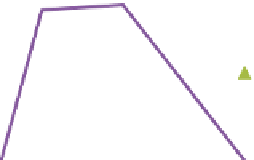Environmental Engineering Reference
In-Depth Information
3. 100% Pine woodchips
4. 100% Pine sawdust
This initial round of experiments provided baseline denitrification rates
for each material. A saline tracer test was undertaken prior to commenc-
ing the testing with site groundwater. The saline tracer testing was used to
determine the particle velocity of the water flowing through the individual
columns. This is governed by the porosity of the carbon material matrix
within each column.
During the denitrification testing, samples were collected from the column
experiments on day 1, 2, 4, and 7. The resulting effluent nitrate concentra-
tions are presented in Figure 7.5. The results indicate that the aged Karri bark
was the most efficient in consistently reducing the concentration of nitrate
throughout the test. In comparison, the pine sawdust was initially ineffec-
tive; however, it improved with time, whereas the pine woodchips were
effective initially but decreased during the course of the test duration.
The results from along the column (Figure 7.6) indicate that the shredded
aged Karri bark also quickly denitrified the groundwater with almost 100%
removal of nitrates within the first 40 cm of the column. In comparison, the
pine sawdust required almost the entire 110 cm to completely denitrify the
groundwater.
The concentrations of both DOC and TOC were measured (Figure 7.7).
In all the columns consisting of carbon, the concentration of both TOC and
DOC in the effluent decreased with respect to time. The results indicate that
the TOC detected in the effluent predominantly consisted of DOC. The con-
centrations in the aged Karri bark effluent were about three times greater
than that for sawdust and six times that for pine woodchips. In addition, the
effluent from the shredded aged Karri bark column had a dark brown color
16
14
12
Sand
Karri bark
Pine wood chips
Pine sawdust
10
8
6
4
2
0
0
2
4
6
8
Time (days)
FIGURE 7.5
Effluent nitrate concentrations from the column experiments.





















Search WWH ::

Custom Search